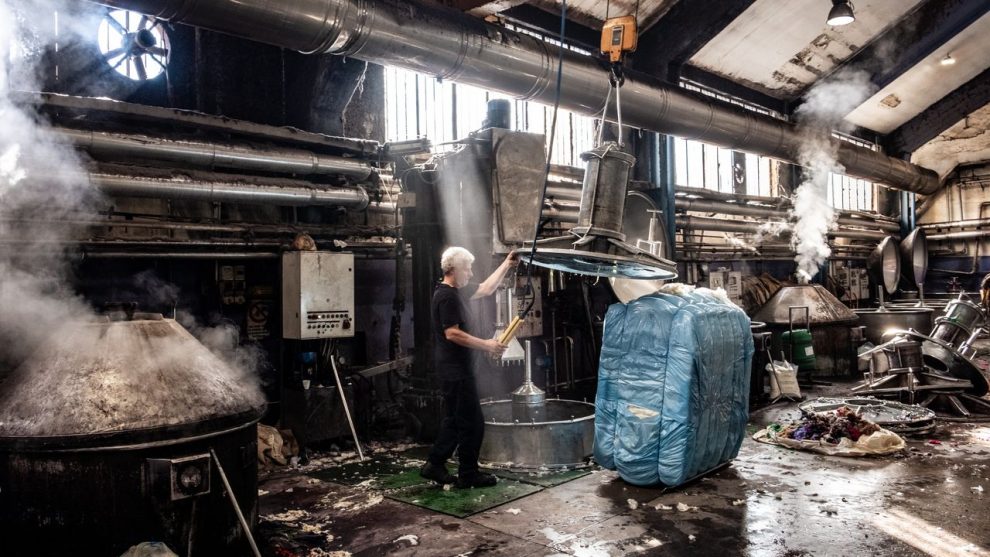Surge in natural-gas and electricity prices imperils factories and workshops; ‘a monster that’s devouring us’
The energy crisis that has closed steel mills and aluminum smelters across Europe is now spreading to the continent’s fashion industry.
Thousands of small factories and workshops that supply brands such as Gucci and H&M have watched their business models unravel amid the surge in natural-gas and electricity prices following Russia’s invasion of Ukraine and its decision to reduce the flow of gas to the continent. Energy costs for many textile makers have risen from about 5% of production costs to around 25%, slashing their profit margins, according to data from European textiles and apparel trade group Euratex.
Energy prices have risen so high, textile makers said, that utilities and other energy vendors, concerned about not getting paid, are demanding that the textile companies secure bank guarantees or come up with cash advances to cover months of expected energy bills. In Italy, Europe’s biggest textile producer, many manufacturers said they can no longer line up energy-purchasing agreements that previously insulated them from short-term price fluctuations.
Italy and some other Southern European nations have asked the European Union to adopt a cap on wholesale gas prices across all member countries, a measure Germany and the Netherlands oppose. The European Commission, the EU’s executive arm, on Tuesday published proposals seeking the power to impose an emergency cap on the price of natural gas on the bloc’s main trading exchange.
At present, the pain is striking up and down the supply chain, from spinners and weavers who consume lots of electricity to transform bales of wool into yarn to fabric dyers who use gas-powered water tanks and industrial-size dryers.
It is difficult for fabric makers to simply pass on those higher costs to buyers. Many are obligated to deliver goods at prices agreed upon months earlier. And higher prices would likely prompt many fashion companies and retailers to shift their business to outside of Europe, where energy prices can be lower. Hanging in the balance are the textile-manufacturing industry’s 1.3 million jobs across the EU.
Alberto Paccanelli, who runs a textile maker in Northern Italy, was stunned when his July gas bill jumped to 660,000 euros, the equivalent of about $650,000, from €90,000 a year earlier.
“What’s happening now is this whole European industry risks going out of business,” said Mr. Paccanelli.
Some brands already are moving production to other countries including Turkey, where production costs are lower, rather than absorbing the extra cost in countries like Italy, according to suppliers. Russia has continued to supply gas and oil to Turkey. Enrico Gatti, a wool maker who supplies Zara, H&M and other brands, said orders have dropped by 50% this year for him and other textile makers around the Tuscan town of Prato, a major textile hub.
A spokeswoman for H&M Hennes & Mauritz AB said the company is “continuously developing our sourcing to mitigate increased energy, raw material and freight costs as well as currency.”
Inditex SA, owner of Zara, says its flexible manufacturing relationships allow it to shift production as needed.
The industry’s problems are laying bare an emerging divide between European countries moving to insulate national industries from surging gas prices and those countries that cannot afford to. Germany announced energy relief measures valued at nearly €300 billion, including price limits on electricity and gas. France plans to spend €100 billion on its own crisis-fighting measures.
Italy doesn’t have the financial firepower for similar measures. The country is saddled with a national debt equivalent to 150% of its gross domestic output, and Giorgia Meloni, the country’s incoming prime minister, has vowed to keep a lid on public spending.
As of late September, Italy had allocated €59 billion, or 3.3% of its GDP, to measures aimed at shielding businesses and households from the energy crisis, according to the Brussels-based Bruegel think tank. Germany had allocated €100 billion, or 2.8% of its GDP, while France had directed €72 billion, or 2.9% of GDP, at the problem.
The divergence is undermining the EU’s single market for goods, said Jean-François Pierre Gribomont, chairman of textiles company Utexbel NV. His weaving operation in Belgium pays €193 per megawatt-hour in that country, double what he paid a year ago. In France, which has directed subsidies at the problem, he pays €123 a megawatt-hour, an annual increase of about 50%, he said. “Why should we have a Europe if every country can do what it wants,” he said.
Michael Engelhardt, head of energy policy for Berlin-based trade association Textil+Mode, said German textile and fashion companies could be poised to benefit from state aid more than peers in some other European countries, but that the firms still have to jockey for public funds with other domestic industries. “If you have the question, ‘Who has the deepest pockets?’ then yes, Germany is all of the time doing well,” he said.
Fabric makers worry they will end up near the back of the line if European capitals are forced to ration gas this winter, because their wares are deemed less essential than other energy-intensive industries such as glass and metals.
“You could argue, ‘Look, if you’re short of fresh new shirts, it’s not the end of the world, you see?’ ” said Dirk Vantyghem, director general of trade group Euratex. But he and other textile-industry representatives and producers said the fashion industry is closely intertwined with broader production of technical and medical textiles that go into such things as air filters, wind turbine blades, artificial human joints and automobile tires.
The steady supply of inexpensive Russian gas allowed manufacturers across Europe to thrive for decades, even while overseas competition increased. Europe’s share of global textile exports has declined over the past 20 years, while China’s has quadrupled to more than 40% as of 2020, more than double the EU’s 2020 share, according to the most recent World Trade Organization data.
Small and medium-size firms have dominated the industry in Europe by forging close, collaborative ties with design houses, and deepening their specialization over generations.
Their spinning and weaving techniques consumed large amounts of electricity, transforming raw fibers imported from New Zealand and Australia into fine thread and fabric. The material is dyed in giant tanks powered by natural gas. Niche companies developed high-quality finishes that require a skilled workforce and command larger profit margins.
Firms clustered in hubs such as Italy’s Lake Como silk district and the Tuscan town of Prato for wool makers. The cooperation gave smaller firms the scale to punch above their weight, competing on price and quality with China and Turkey to produce fabric for brands with global reach.
When energy prices began to surge a year ago, many small firms found it hard to absorb the extra costs. Natural-gas prices across Europe rose nearly 10-fold over a year, peaking in late August, as producers worked to turn around collections that had been priced much earlier in the year.
Maurizio Sarti, a luxury wool maker in Tuscany, said he raced to fill orders in two months’ time but couldn’t keep up with the rising gas prices. “You set a price, and then the cost of gas doubles,” he said. “I can’t pass the increase on to my client.”
Vincenzo Cangioli, another high-end wool maker from Prato, discovered he could no longer renew his long-term gas purchasing agreement, at any price. That forced him to start buying gas on a month-to-month basis. His bill for the month of July was €340,000, compared with €450,000 for all of 2021.
“If I look at our profile in February and the July profile, what I have is two completely different businesses, which is very scary,” he said.
Guido Nesti, who owns a dyeing operation in Prato with 30 employees, spoke to his gas vendor in September hoping to renew a purchasing agreement that typically lasts a year or more. Like many business owners across Italy, Mr. Nesti was accustomed to negotiating in the summer when demand for the fuel is low and storage facilities across the continent are filling up.
This time, Mr. Nesti said, the vendor asked him for a cash advance equivalent to at least two months of gas bills. The 65-year-old was incredulous. Gas prices were 10 times the level of a year ago, making two months of payment an unprecedented sum, he said.
Mr. Nesti spread word to another dyer in the area, Fabio Reali, whose own purchasing agreement was due to expire in December. Mr. Reali calculated, based on his bills in July and August, that he would have to come up with about one million euros to cover two months of gas bills if his vendor made a similar demand. To make it through the year, he would have to burn more than half of his €10 million in annual revenue on energy bills, compared with the 10% he used to spend.
The cost of gas, he said, had gone from being “one of the thousand business costs” that he rarely thought about to “a monster that’s devouring us.”
Mr. Reali called an emergency meeting of his department heads, telling them the next few weeks would be make-or-break. Heating large water tanks to dye fabrics had become so expensive that the firm could afford only two to three more months of losses before shutting its doors.
Mr. Reali had been gradually raising his prices since Russia invaded Ukraine. When Moscow decided this summer to first restrict, then close, the Nord Stream pipeline, a vital artery for Europe’s gas supply, gas prices rose to more than 10 times what Mr. Reali had paid a year earlier.
That made Mr. Reali’s energy costs too high to pass down the supply chain. The usual buyer of his dyed fabric, the wool maker Mr. Gatti, had years of experience negotiating with major brands, navigating the pandemic and other crises.
Mr. Gatti said he recently sent Zara fabric to produce prototypes of a coat and other garments, lining his firm up to produce around 200,000 yards of fabric for the brand. When he pressed Zara to absorb the extra energy costs he and Mr. Reali were incurring, however, Zara backed out, he said.
Mr. Gatti saved some money by running his mechanical looms during the evening when the price of electricity was lower. But Mr. Reali’s operations didn’t have the same flexibility. Powering down and heating up giant dyeing tanks consumes large amounts of gas. Running them for only three-day stretches, Mr. Gatti said, would delay delivery and trigger penalties from Zara.
“The important brands don’t want to hear about it,” he said. “They want to maintain their margins.”
Source: WSJ






















